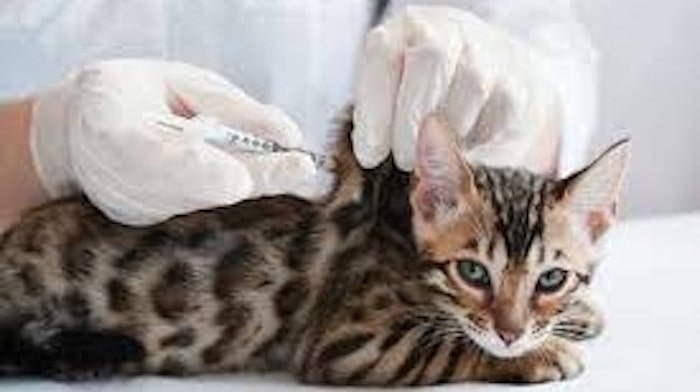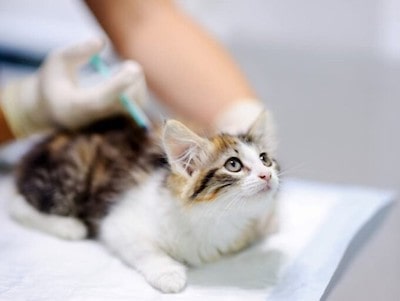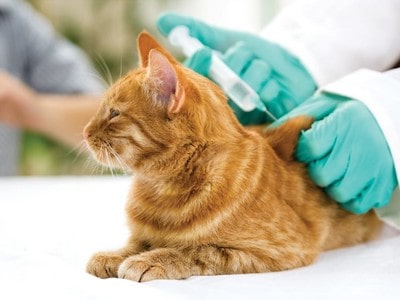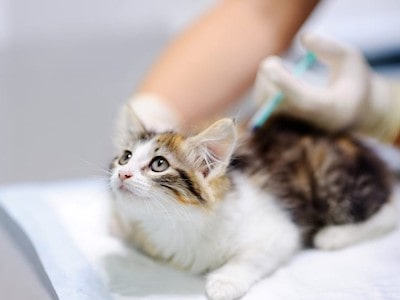As a responsible cat owner, it’s crucial to ensure the well-being and longevity of your feline companion. One of the most important steps in safeguarding their health is providing them with appropriate vaccinations. While there are several vaccinations recommended for cats, one that stands out is the FVRCP vaccination.
FVRCP, which stands for Feline Viral Rhinotracheitis, Calicivirus, and Panleukopenia, is a combination vaccine designed to protect cats against three highly contagious and potentially life-threatening viral diseases. This powerful immunization has played a significant role in preventing the spread of these illnesses among feline populations worldwide.
In this article, we will delve into the details of FVRCP vaccination, discussing its purpose, the diseases it protects against, recommended vaccination schedules, and any potential side effects. By understanding the importance of FVRCP vaccination, you’ll be equipped with the knowledge to make informed decisions about your beloved cat’s healthcare.
So, let’s embark on this journey to uncover the significance of FVRCP vaccination and the impact it can have on the health and happiness of your feline friend.
FVRCP: What Does It Mean?
FVRCP is an acronym for Feline Viral Rhinotracheitis, Calicivirus and Panleukopenia. These are three common and contagious viruses that can cause serious illness and even death in cats. Let’s take a closer look at each of them.
FVR is caused by a herpes virus that infects the upper respiratory tract of cats. It is also known as feline herpesvirus 1 or FHV-1. It is one of the most common causes of upper respiratory infections (URIs) in cats, especially in shelters, catteries and multi-cat households.
Symptoms of FVR include sneezing, runny nose, watery eyes, fever and sometimes pneumonia or mouth ulcers. The infection can be very painful and uncomfortable for your cat, and can interfere with their breathing, eating and drinking. In severe cases, FVR can be life-threatening, especially in kittens, elderly or immunocompromised cats.

FVR is a lifelong infection that can flare up when the cat is stressed or exposed to other infections. This means that even if your cat recovers from the initial infection, they may still carry the virus and show signs of illness again in the future. The virus can also be shed in their saliva or eye secretions, which can infect other cats.
There is no cure for FVR, only supportive treatment to manage the symptoms and prevent secondary infections. Your veterinarian may prescribe antibiotics to treat bacterial complications, antiviral drugs to reduce viral shedding, eye drops to soothe eye irritation, and painkillers or anti-inflammatory drugs to relieve discomfort.
You can also help your cat by keeping them warm and hydrated, cleaning their nose and eyes with a damp cloth, and providing them with a humidifier or steamy bathroom to ease their breathing.
Feline Calicivirus (FCV)
Cats are frequently infected with FCV in addition to FVR, another virus that affects the upper respiratory tract. Cat calicivirus, or FCV, is another name for it. FCV infection affects up to 80% of cats that have URIs, according to estimates.
Similar to FVR, FCV symptoms can also include mouth ulcers, joint swelling, and limping. Your cat may find it extremely difficult to eat or drink due to these sores, which can cause dehydration and weight loss. Your cat’s quality of life may be impacted by the limping and joint swelling, which may make them unwilling to play or move about.

FCV can potentially result in a more dangerous condition that can harm internal organs and be deadly. This is also known as hemorrhagic calicivirus or virulent systemic feline calicivirus (VS-FCV). It results in signs including bleeding from the mouth, nose, or skin, jaundice, swelling of the face or limbs, breathing problems, and sudden death. This strain is uncommon yet dangerous and very infectious.
FCV can persist in the environment and be shed by asymptomatic carriers. This means that your cat can get infected by contact with other cats, people or objects that are contaminated with the virus. The virus can survive on surfaces for up to a month, so it is important to disinfect any areas where an infected cat has been.
There is no cure for FCV, only supportive treatment to manage the symptoms and prevent secondary infections. Your veterinarian may prescribe antibiotics to treat bacterial complications, anti-inflammatory drugs to reduce inflammation and pain, fluids to prevent dehydration and nutritional supplements to boost your cat’s immune system.
You can also help your cat by keeping them comfortable and hydrated, offering them soft food or watered-down canned food, and providing them with toys or enrichment to keep them stimulated.
Feline Panleukopenia (FPV)
FPV is also known as feline distemper or feline parvovirus. It is a highly contagious and deadly virus that attacks the gastrointestinal tract and immune system of cats. It is not related to canine distemper or parvovirus, but it belongs to the same family of viruses.
Symptoms of FPV include anorexia, vomiting, diarrhea, fever and dehydration. The vomiting and diarrhea can be severe and bloody, leading to shock and death.
The virus also attacks the bone marrow and lymph nodes, which leads to a very low white blood cell count and prevents the cat from being able to activate their immune system normally. This makes them vulnerable to secondary infections and complications.
FPV can also cause abortion or birth defects in pregnant cats or neurological problems in kittens. The virus can cross the placenta and infect the unborn kittens, causing them to be stillborn, malformed or weak. The virus can also affect the developing brain of kittens, causing them to have tremors, seizures or poor coordination.

FPV can survive in the environment for a long time and be transmitted by contact with infected animals, feces or contaminated objects. The virus is very resistant to disinfectants and can remain infectious for up to a year. It can also be carried by other animals such as dogs, raccoons or rodents, which can spread it to cats.
There is no cure for FPV, only supportive treatment to manage the symptoms and prevent dehydration and secondary infections.
Your veterinarian may prescribe antibiotics to treat bacterial complications, fluids to prevent shock and organ failure, anti-nausea drugs to control vomiting and diarrhea, and blood transfusions to replace lost blood cells.
You can also help your cat by keeping them warm and hydrated, offering them bland food or chicken broth, and isolating them from other cats or animals.
Why Is FVRCP Vaccine Important for Cats?
As you can see, these three viruses can cause serious harm to your cat’s health and wellbeing. They can cause severe pain, discomfort, organ damage and death. They can also affect your cat’s quality of life and happiness. The good news is that there is a safe and effective way to protect your cat from them: the FVRCP vaccine.
The FVRCP vaccine is considered a core vaccine for all cats, regardless of their lifestyle. This means that even indoor-only cats should receive it, as they can still be exposed to these viruses through contact with other cats, people or objects.
For example, you may bring home the virus on your shoes or clothes after visiting a friend with a cat, or your cat may escape outside and encounter a stray cat that is infected.
The FVRCP vaccine works by stimulating your cat’s immune system to produce antibodies that can fight off these viruses if they encounter them. The vaccine does not contain live viruses, so it cannot cause infection or disease in your cat. However, it may cause some mild side effects such as soreness at the injection site or lethargy for a day or two.
The FVRCP vaccine is not only beneficial for your cat, but also for the cat population as a whole. By vaccinating your cat, you are reducing the spread of these viruses in the environment and among other cats.
This helps protect cats that are not vaccinated or have weak immune systems, such as kittens, elderly or sick cats. It also helps prevent outbreaks of these diseases in shelters, catteries and communities.
When Should My Cat Get the FVRCP Vaccine?
The FVRCP vaccine schedule may vary depending on your cat’s age, health status and risk factors. However, a general guideline is as follows:
- Kittens should receive their first FVRCP vaccine at 6 to 8 weeks of age, followed by booster shots every 3 to 4 weeks until they are 16 weeks of age. This is because kittens are more susceptible to these viruses and need multiple doses to build up their immunity.
- Adult cats should receive a booster shot one year after their last kitten shot, then every 3 years thereafter. This is because their immunity may wane over time and need periodic boosters to maintain it.

- Pregnant or nursing cats should not receive the FVRCP vaccine, as it may harm their unborn or nursing kittens. They should be vaccinated before breeding or after weaning their kittens.
- Cats that have been previously infected with these viruses may still benefit from the FVRCP vaccine, as it may boost their immunity and protect them from reinfection or reactivation of the virus.
Your veterinarian will advise you on the best vaccination plan for your cat based on their individual needs. They will also perform a physical exam and ask you about your cat’s medical history before administering the vaccine. They will also monitor your cat for any adverse reactions after the vaccine and provide you with instructions on how to care for your cat at home.
What Are the Side Effects of the FVRCP Vaccine?
Most cats tolerate the FVRCP vaccine well, with minimal or no side effects. However, some cats may experience mild reactions such as:
- Pain, swelling or redness at the injection site
- Lethargy or loss of appetite
- Fever or chills
- Sneezing or nasal discharge
These side effects usually resolve within a day or two and do not require any treatment. However, if they persist or worsen, you should contact your veterinarian.
In rare cases, some cats may develop more serious reactions such as:
- Hives or itching
- Difficulty breathing or swallowing
- Vomiting or diarrhea
- Seizures or collapse
These are signs of an allergic reaction or anaphylaxis , which can be life-threatening. If you notice any of these signs, you should seek immediate veterinary attention. Your veterinarian may administer antihistamines, steroids or epinephrine to counteract the reaction and stabilize your cat.
The risk of these serious reactions is very low, and much lower than the risk of contracting these deadly viruses. Therefore, the benefits of the FVRCP vaccine outweigh the potential risks for most cats.
FAQs
At what age should my cat receive the FVRCP vaccination?
Kittens should receive their first FVRCP vaccination at around 6 to 8 weeks of age. The vaccine is typically administered in a series of boosters, with additional doses given every 3 to 4 weeks until they reach 16 weeks of age. Adult cats may also require regular FVRCP booster shots to maintain immunity.
Can indoor cats skip the FVRCP vaccination?
Even if your cat is strictly indoors, it is still recommended to vaccinate them against FVRCP. Viruses can be brought into the household through various means, including on clothing or through open windows. Vaccination helps ensure that your cat is protected in case of any potential exposure.
How often should my cat receive FVRCP booster shots?
After the initial series of vaccinations, adult cats typically receive FVRCP booster shots every 1 to 3 years, depending on the specific vaccine used and the veterinarian’s recommendation. Regular booster shots help maintain the cat’s immunity against these diseases.
Are there any precautions I should take before and after FVRCP vaccination?
Before vaccination, it’s essential to ensure that your cat is in good health. Your veterinarian may recommend specific precautions depending on your cat’s age, medical history, and overall condition. After vaccination, monitor your cat for any unusual reactions and contact your veterinarian if you have any concerns.
Conclusion
FVRCP vaccination is a vital component of responsible cat ownership, ensuring the health and well-being of our feline friends. By understanding the significance of FVRCP vaccination and its ability to protect against Feline Viral Rhinotracheitis, Calicivirus, and Panleukopenia, cat owners can make informed decisions about their pet’s healthcare.
Through the administration of the FVRCP vaccine, we can prevent the spread of highly contagious and potentially life-threatening diseases among feline populations. Starting with the initial vaccination series for kittens and continuing with regular booster shots for adult cats, we can help maintain their immunity and keep them safe from these viral threats.
While mild side effects may occur, such as temporary lethargy or mild swelling at the injection site, the overall benefits of FVRCP vaccination far outweigh the potential risks. It is crucial to consult with a veterinarian to determine the appropriate vaccination schedule and address any concerns or questions.
